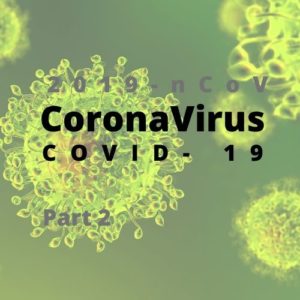2019-nCoV | Coronavirus Part 2


Part 1 reviews the viral nomenclature, disease name and symptoms.
This article is a result of publishings from the American Optometric Association, the American Academy of Ophthalmology (AAO), the Centers for Disease Control (CDC) and the World Health Organization (WHO).
Transmission
The exact mechanisms of transmission are not known about the novel coronavirus, called 2019-nCoV. Person-to-person spread is certain and is consistent with what is known about other coronaviruses.
Person-to-person transmission occurs between two people who are in close contact with one another; close contact being defined as within 6 feet of one another. Infectious respiratory droplets are aerosolized when a person coughs or sneezes. The droplets may land in the mouths or noses (eyes ?) and cause infection. Rubbing your eyes or nose also leads to spread of the virus. It is possible that virus particles become inhaled and gain entry via the lungs.
Touching an infected surface or object may be lead to infection, but this mechanism of action has yet to be proven.
Preventing Spread of Coronavirus
The CDC recommendations for prevention include:
- Thorough handwashing with warm soap and water
- Use alcohol-based sanitizer with at least 60% alcohol if soap/water not available
- Covering your mouth and nose when sneezing (actually sneeze into the crook of your arm to avoid contamination of your hands)
- Avoid close contact with someone who may be ill
- Avoid touching your eyes, nose and mouth
Incubation time for the coronavirus is theorized to be about 2-14 days, but there is evidence that this may be longer. Individuals may be shedding the virus yet be totally asymptomatic. Incubation time is defined as the time between contracting the COVID-19 virus and showing the first symptoms.
Persons Under Investigation (PUI)
The Centers for Disease Control have the following recommendations for healthcare providers who encounter patients suspected of having COVID-19.
Patients suspected of having contracted COVID-19 are “Persons Under Investigation” (PUI).
Healthcare providers are asked to obtain a detailed travel history when encountering patients with fever and shortness of breath. Patients of conjunctivitis should be evaluated for fever and shortness of breath.
Travel history is used to identify patients who have recently travelled to mainland China, especially Hubei Province, China OR patients who have had close contact with a patient with confirmed 2019-nCoV infection within 14 days of showing symptoms. (With recent outbreaks in other countries, this advice may change.)
Concerned healthcare providers are to contact state and local health authorities.
CDC's Emergency Operations Center: 770.488.7100.
